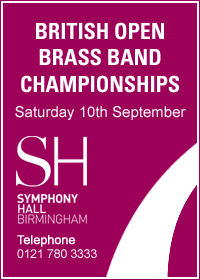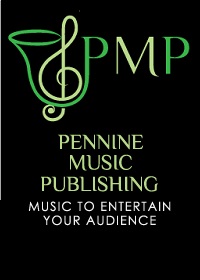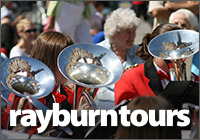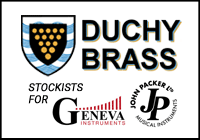2007 European Brass Band Championships - Own Choice selections
30-Apr-20074BR has a look at the selections made by the bands to showcase their abilities and try and win valuable points to cbecome European Champions.
 Music of the Spheres - Philip Sparke
Music of the Spheres - Philip Sparke
(To be played by four bands)
Music of the Spheres was written late 2003/early 2004 and reflects the composer's fascination with the origins of the universe and deep space in general.
The title comes from a theory, formulated by Pythagoras, that the cosmos was ruled by the same laws he had discovered that govern the ratios of note frequencies of the musical scale. (‘Harmonia' in Ancient Greek, which means scale or tuning rather than harmony – Greek music was monophonic). He also believed that these ratios corresponded to the distances of the six known planets from the sun and that the planets each produced a musical note which combined to weave a continuous heavenly melody (which, unfortunately, we humans cannot hear). In this work, these six notes form the basis of the sections MUSIC OF THE SPHERES and HARMONIA.
The pieces opens with a horn solo called t = 0, a name given by some scientists to the moment of the Big Bang when time and space were created, and this is followed by a depiction of the BIG BANG itself, as the entire universe bursts out from a single point.
A slower section follows called THE LONELY PLANET which is a meditation on the incredible and unlikely set of circumstances, which led to the creation of the Earth as a planet that can support life, and the constant search for other civilisations elsewhere in the universe.
ASTEROIDS AND SHOOTING STARS depicts both the benign and dangerous objects that are flying through space and which constantly threaten our planet, and the piece ends with THE UNKNOWN, leaving in question whether our continually expanding exploration of the universe will eventually lead to enlightenment or destruction.
 Journey to the Centre of the Earth - Peter Graham
Journey to the Centre of the Earth - Peter Graham
(To played by one band)
The French novelist Jules Verne (1828 - 1905) created a unique blend of science and adventure in his series of novels known as "Voyages Extraordinaires". Written in 1864, Journey to the Centre of the Earth is on the surface an adventure story but as the commentator Diana Mitchell has observed on a deeper level can be seen as "man's journey of himself, always probing deeper for what lies at the centre".
The novel takes the form of a sequence of diary entries by Axel, nephew of Professor Otto Lidenbrock. The pair follow coded instructions in an old document guiding them to Iceland where, together with their guide Hans, they enter the open crater of an extinct volcano Snæfells and pursue a trail to the centre of the earth. There follows "hair-breadth escapes and ventures perilous" as the intrepid explorers encounter a vast interior world.
This music presents scenes from the novel in a rough chronological order. The work opens on the dark and brooding Summit of Snæfells and follows the adventurers as they descent into the bowels of the earth. En- route they encounter the Wonders of the Terrestrial Depths (an electrically illuminated sky), a dream sequence during which Axel witnesses a Battle of Antediluvian creatures before the final Ascent and Homecoming. The key scene of the book (and the music) reflects on Axel's despair as he becomes separated from the his companions and is Lost in the Labyrinth. His subsequent rescue is due to an acoustic phenomenon whereby he hears the voices of his friends in The Whispering Gallery.
Journey to the Centre of the Earth is dedicated to Ryan and Megan, who love the story!
Peter Graham
Cheshire
March 2005
 Vienna Nights – Philip Wilby
Vienna Nights – Philip Wilby
(To be played by two bands)
Philip Wilby's masterful fantasy on Mozart's Piano Sonata in A, K331 is arguably his finest work for brass band and will become an instant classic of the genre. No other composer for brass could so successfully bring together two such diverse strands of compositional matter and architecture into one coherent symbiotic relationship like he has done here. It is a breathtaking achievement of subtle mastery for Wilby has achieved the musical equivalent of turning base metal into pure gold. This is brass band compositional alchemy, and the result is quite startling.
The key is perhaps found in the subtitle to ‘Vienna Nights' itself. Wilby calls it a ‘fantasy' which allows him the scope to develop his own thoughts and themes, structures and ideas without ever losing the purity of the original thematic material. It is not an arrangement, realization, transcription of straight copy and paste job of the original with added on bits. If it were, it would have been a disaster. What we get therefore is a classically structured piece in Sonata form where the germ of the original musical thought is developed without ever changing its historical DNA.
The Mozart music that forms the basis of the work is untouched and allowed to stand alone in all its glory, however brilliantly Wilby surrounds it with his kaleidoscopic array of inspired personal ideas. It is therefore a piece that delineates the dichotomies between the two composers to the full – the almost simplistic beauty of Sonata and the joie-de-vivre of the Turkish Rondo allied to the intervening more muscular and complex layers of Wilby and his own homage to the 12 tone harmonics of Schoenberg. The result as we have said – is quite something indeed.
The piece, played in one continuous movement is broken into the sonata form: The first entitled ‘Freud's Dreams' is itself homage to the great thinker and father of psychoanalysis. This short introductory section leads to part 2 – ‘Variations' which itself is broken into a series of continuous variations on the Mozart theme from the Piano Sonata. The nine mini variations cover just about every aspect of musical development you can think of, but always at their core is a pure circulatory bloodline, like a series of veins and arteries connecting every musical strand to the Mozart heart. The third section is marked ‘Scena and Notturno' and is the most operatic in style and content before that itself sets the scene for the finale.
This is the romp of the ‘Finale Alla Turca' brought to life with an injection of pace that would leave the sprinter Marion Jones in her tracks. This is still very much Mozart, but Mozart on a diet of Red Bull chasers – it's wickedly joyful, devilishly difficult and quite amazing to listen too (and we suspect to play).
 Contest Music - Wilfred Heaton
Contest Music - Wilfred Heaton
(To be played by one band)
Contest Music was written in 1973 and was to be used as the test piece for the National Championships of Great Britain. It wasn't, and the decision not to use the work was quite simply a disgrace. It finally found favour with the organisers in 1982 and since that time it has widely been acknowledged as one of the very finest compositions for brass band ever written.
Ironically, the work was actually played at the Royal Albert Hall before that 1982 date, when the Swedish Band, Solna Brass conducted by G. Borkland used it as their own choice selection at the inaugural European Championships. Sine that time it has been played at very nearly every major brass band contest both in the UK and abroad.
The programme noted for the 1982 National Finals state that Contest Music follows a tradition of similar pieces for the brass medium by Elgar, Holst and Ireland in placing musical content first and instrumental virtuosity second. The music exists solely for itself and allies itself with 18th and 19th century classicism.
The work is in three movements - fast, slow, fast. In the outer movements the constant metamorphosis of material reflects classical procedures. The middle movement in contrast contains no development and is lyrical from beginning to end.
I. Adheres roughly to Sonata form, but the re-capitulation material is presented in inverted and reversed order.
II. Opens and closes with a tonally ambiguous dialogue between trombones moving harmonically and cornets in a single line. Between lies a continuously unfolding melodic line, restrained both dynamically and emotionally.
III. Is akin to the classical Rondo with a four fold statement of the main theme, its outline being changed and its pitch raised at each repetition.
 Tristan Encounters – Martin Ellerby
Tristan Encounters – Martin Ellerby
(To be played by one band)
Tristan Encounters (Prelude and Transfigurations for Brass and Percussion) was commissioned by Philip Biggs and Richard Franklin with funds provided by the Foundation for Sport and the Arts, for the 1999 All England Masters Brass Band Championships which was won by the Yorkshire Building Society Band conducted by David King.
The work is derived from Wagner's Prelude to the opera "Tristan and Isolde" and comprises a series of mood pictures that alternate between the romantic and the tri tone style of aggressive music. These alternates are sometimes severe throughout the 14 transfigurations (Wagner's descriptive word for variations) and although the composer uses quotes from the Prelude it is very much music of the modern genre.
Although the work is continuous each transfiguration is well defined even if it may only be brief in time, with the crux of the whole piece coming in a series of cadenza features for soprano, cornet, euphonium, flugel horn, baritone, trombones, Eb bass and Bb bass at transfiguration 12.
The composer enigmatically notes that "I am sure there is something of all our experiences in this work – which ones are yours?" The work is dedicated to Rodney Newton.
 Of Men and Mountains – Edward Gregson
Of Men and Mountains – Edward Gregson
(To be played by one band)
The piece was commissioned by the Netherlands Brass Band Championships for their 10th anniversary contest which was held in Drachten in December 1991. The first British performance was a t the fifth conference of the World association for Symphonic Bands and Ensembles held at the Royal Northern College of Music in July 1991.
The title of the work and its genesis came about as a result of a train journey made by the composer and his wife in July 1989 across Canada from Toronto to Vancouver. The awe inspiring journey through the Rocky Mountains with its peaks and shafts of sunlight breaking through the clouds, with its canyons and ferocious rapids made the composer understand a little more about the majesty of nature and the fragility of humanity. The eternal struggle between man and nature was personified in the building of this incredible railway, hence the title.
The work is dedicated to the memory of Eric Ball, who died shortly before the composer commenced writing the piece. The actual title comes from William Blake's ‘Great things are done when men and mountains meet; This is not done by jostling in the street' from the poet's ‘Other Notes' publication of 1793.
Of Men and Mountains is in one continuous movement lasting about 17 minutes. Its form is difficult to describe because of its motivic and accumulative nature, but it is essentially a symphonic tone poem in search of a theme, which eventually comes in its final and complete state in the majestic ending after an ever increasingly paced scherzo.
Beyond the Horizon - Paul H. Kelly
(To be played by one band)
The primary inspiration for this piece is based on a simple question which people have been asking themselves for centuries: ‘What is there beyond the horizon?'. Until the 6th century A.D., the Earth was represented as a flat surface, and scientists and navigators thought that if they came to its end, they would fall into strange and mysterious worlds populated by devilish creatures.
The beginning of this piece draws from this somewhat obscure theory which is described by music of a similar character. The rather mysterious introduction thus brings us to the strange lands that, according to people in Antiquity, circled our planet. The following part introduces very violent and tortured music that pictures the endless fall of the men who ventured ‘beyond the horizon'. A slow and deeply enigmatic moment ensues.
It tries to depict the unknown, that is to say what science at that time could not explain and was therefore often explained by religion. It ends on a long euphonium cadenza which represents the theory defended by several scientists, including Copernicus and Galileo, who thought that the Earth was round and revolved at the same time on itself and around the sun.
This brings us to the second part of the piece which is made of much brighter and more optimistic music describing the modern scientific theories still in use nowadays. The music is cyclic, which in a way answers the question ‘What is there beyond the horizon?'. In fact, the answer is that there is always our familiar world, inhabited maybe by people from different ethnic groups or cultures but nevertheless as human as we are. They have a horizon of their own, which is not ours but certainly has made them ask themselves this same question.
The title ‘Beyond the Horizon' also has a second meaning. This extremely demanding piece in fact seeks to go beyond all difficulties, either technical, musical, or else.
Titans Progress - P. Alliston
(To be played by one band)
At present we do not have any information about this piece.















